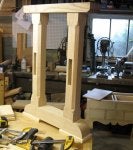For an absolute amateur, I was well pleased to tap the three pieces together for the two pedestals for dining table and to see they are much better than I had imagined. The words measure twice, cut once is the best advice I ever listened to.
Grateful for any ideas on how to use the router to soften the edges and showcase the wood.
thanks to one and all
Grateful for any ideas on how to use the router to soften the edges and showcase the wood.
thanks to one and all


![IMG_1107[1].jpg](/d3/attachments/62/62856-576dd14419c2cbd8e76e833feecf1755.jpg)
![IMG_1109[1].jpg](/d3/attachments/62/62863-248f846b971e7e9c28d477ada96a048b.jpg)
![IMG_1110[1].jpg](/d3/attachments/62/62873-7082c2306cb5cb7df8b676d9262c43ba.jpg)
![IMG_1111[1].jpg](/d3/attachments/62/62874-c4bab6ac561dadb0f31bf3c71a9fb734.jpg)
![IMG_1112[1].jpg](/d3/attachments/62/62875-0f2829b9302e84c0d69d8f658cedec40.jpg)

![IMG_1124[1].jpg](/d3/attachments/62/62890-85c17b462308cf53d27aaa2831c6a948.jpg)


![IMG_1125[1].jpg](/d3/attachments/62/62933-620722bb550dade0bba47f7ceb3f4019.jpg)
![IMG_1128[1].jpg](/d3/attachments/62/62934-ae6481fd421cbabc1c159aee54e7b255.jpg)
![IMG_1127[1].jpg](/d3/attachments/62/62935-69ff86a93fa0dcca8a0d1cdbaf7d53b4.jpg)


